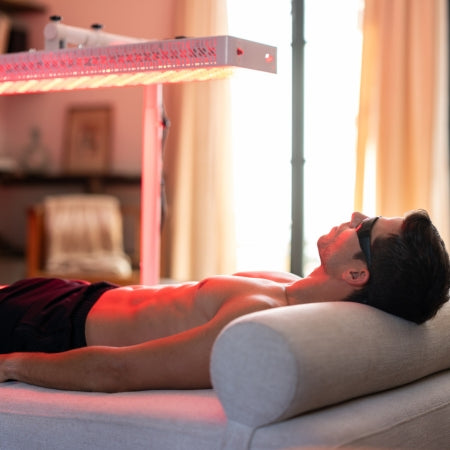How is Red Light Therapy good for health?
Like water and nutrients from food, our bodies need natural light to perform and thrive.
Red and near-infrared wavelengths of light are the ‘superfoods’ of natural light. Through absorption via the skin, these wavelengths can provide our bodies with myriad healing properties and health benefits.
Orion uses medical-grade 5 watt LEDs to deliver red and near-infrared light to your cells. The light emitted acts like the wavelengths of light from natural sunlight, but without the heat, harmful UV rays, or need to rely on the weather.
The mechanisms of red light therapy can lead to improved mental acuity, quality of sleep, skin health, muscle recovery, brain health, inflammation, and joint pains -among many other aspects to optimize one’s overall health.
See the full list of Orion RLT benefits here.

What is Red Light Therapy?
Red light therapy refers to therapeutic treatments of red & near-infrared lights via LEDs. These specific wavelengths mimic wavelengths from the sun (a source of nutrients that is essential to our health in practically every way).
Red light therapy is also known as: RLT, photo-biomodulation (PBM), phototherapy, LED therapy, LED light therapy, low-level laser therapy, and low-level light therapy (LLLT).
Red light therapy is not: infrared saunas (or any other sauna type), artificial light treatment, bright light therapy from a light therapy lamp, or light box.
Where did Red Light Therapy come from?
Light therapy technology has been used in medicine throughout cultures internationally for decades. Within North America, NASA spearheaded some of its more well-known and in-depth research during the 1980’s and 90’s. Breakthroughs in LED lighting technology shortly after made affordable home devices like Orion, possible. Major advances in clinical light therapy research and increased public interest in natural health technology have also contributed to the growing use and popularity of red light therapy.
How does Red Light Therapy work?
Red light therapy is a non-invasive treatment that delivers concentrated red and near-infrared light to your cells. All you need is 10-15 minutes per day (regularly) to fully leverage its benefits.
Red light therapy delivers full-body benefits by using medical-grade 5w LEDs to project clinically proven red and near-infrared wavelengths to your body. These lights will fall under a wavelength spectrum of the sun, which travels between 620 nanometers (nm) to 1200 nm. The difference in nanometers dictate its travel distance beyond the skin.
The health benefits of red light therapy are driven from 3 different mechanisms: (1) increase mitochondrial function, (2) improve blood circulation, and (3) decrease oxidative stress.
Mitochondrial Function
Red light therapy boosts our energy production at a cellular level, specifically in the mitochondria—the 'powerhouse' of the cell [1,2]. Natural red and near infrared light from red light therapy enhances the cellular respiration process that creates adenosine triphosphate (ATP) energy, often called "the energy currency of life". Our bodies are constantly creating ATP to fuel everything we do. The more ATP our cells can produce, the better our bodies can heal, feel, and perform.
Blood Circulation
Blood circulation is a vital function. It delivers essential nutrients and oxygen to our brain and body. Red light therapy improves blood flow by stimulating the cellular production of Nitric Oxide (NO) [3,4], which aids blood circulation and thereby enables our cells to take in oxygen and nutrients more easily. As a result, one might experience improved skin health, wound healing, and reduced muscle soreness – along with decreased risks of heart disease, organ failure, and inflammation.
Oxidative Stress
Oxidative stress is an imbalance between free radicals and antioxidants in our body. Free radicals are harmful molecules, which are naturally produced through metabolic activities (like digestion and exercising). Antioxidants play a central role in offsetting free radicals and reducing oxidative stress. Uncontrolled levels of oxidative stress can accelerate aging and lead to cell injury. Red light therapy upregulates the production of antioxidant enzymes [5,6,7] - reducing oxidative stress and preventing further damage to cells.
The difference between Red and Near-Infrared light

The difference between red and near-infrared light is in its ability to penetrate through the skin (dermis and epidermis).
Red light uses a shorter wavelength that range from 620-750 nanometers (nm) and is readily absorbed by the surface layer of the skin. Red light is known to increase collagen, energy production, and improve sleep, among many other health benefits.
Near-infrared light uses a longer wavelength that ranges from 750-1200 nm and can reach into deeper tissues of the body for other health benefits, such as improving muscle recovery, joint pain, inflammation, mental acuity, and thyroid function.
Orion uses the most effective and clinically proven wavelengths of red, at 660 nm, and near-infrared, at 850 nm, light for full-body health benefits.
How to use Red Light Therapy
Red light therapy treatments are simple and can be very effective when complemented with other healthy lifestyles. Follow Orion’s treatment guideline for the best results:
- Position yourself 6-12 inches away from your device.
- Expose your skin for the most effective results.
- Approximately 10-15 minute treatments per body area and up to 20 minutes for symptomatic areas.
- 1-2 treatments per day.
- Any time of day that works best for you.
Shop the Orion lineup to find the best device that suits you.
[1] Freitas, L. & Hamblin, M. (2016). Proposed mechanisms of photobiomodulation or low-level light therapy". IEEE Journal of Selected Topics in Quantum Electronics, 22(3): 2-37.
[2] Hamblin, M. R. (2017). Mechanisms and Mitochondrial Redox Signaling in Photobiomodulation. Photochemistry and Photobiology. 2018, 94:199-212.
[3] Ihsan, F. R. M. (2005). Low-level laser therapy accelerates collateral circulation and enhances microcirculation. Photomedicine and Laser Surgery, 23(3): 289-294.
[4] Maegawa, Y., …, & Nishi, M. (2000). Effects of near-infrared low-level laser irradiation on micocirculation. Lasers in Surgery and Medicine 27:427-437.
[5] Marchi, T. D., Junior, E. C. P. L, Bortoli, C., Tomazoni S. S., Lopes-Martins, R. A. B., & Salvador, M. (2011). Low-level laser therapy (lllt) in human progressive-intensity running: effects on exercise performance, skeletal muscle status, and oxidative stress. Laser Medical Sciences.
[6] Macedo, R. S., ..., & Lino-dos-Santos-Franco, A. (2016). Photobiomodulation therapy decreases oxidative stress in the lung tissue after formaldehyde exposure: role of oxidant/antioxidant enzymes. Hindawi Publishing Corporation.
[7] Salehpour,F., Mahmoudi, J., Kamari, F., Sadigh-Eteghad, S., Rasta, S. H., & Hamblin, M. R. (2018). Brain photobiomodulation therapy: a narrative review. Molecular Neurobiology, 55(8): 6601-6636.


































